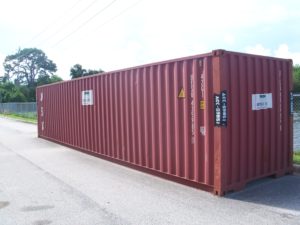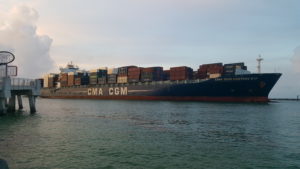A person who offers a hazardous material (HazMat) for transport to, from, or through the U.S. must comply with the Hazardous Materials Regulations (HMR) of the Pipeline and Hazardous Materials Safety Administration within the U.S. Department of Transportation (USDOT/PHMSA). If a person offers for transport a dangerous good (dangerous good is the term used by international regulations to refer to what we in the U.S. call a hazardous material) for transport by vessel in international waters that person must also comply with the International Maritime Organization (IMO) and its Dangerous Goods Code (IMDG Code).
The challenge for a shipper is knowing when to comply with the HMR and when compliance with the IMDG Code is required. To summarize the requirements: a shipper may comply with the IMDG Code – even for transport within the U.S. if all requirements of the IMDG Code are met and the shipper complies with 49 CFR 171.22 and §171.25.
The purpose of this article is to explain the requirements for the loading of cargo transport units (CTUs) for transport by vessel in compliance with Chapter 7.3.3 of the IMDG Code.
Before we begin…
This article is based on the 2018 edition of the IMDG Code containing amendments 39-18. This edition alone must be used to determine compliance in 2020 but is optional for use in 2019. The 2016 edition, which includes amendments 38-16, is also optional for use in 2019. It alone was mandatory in 2018. Confused? Read: The IMDG Code Amendment Cycle.
For the purposes of this article it doesn’t matter which edition is used. The effective regulations are unchanged between the two.
Scope:
The regulations of Chapter 7.3 of the IMDG Code apply to those persons responsible for the loading of the CTU. This may be the shipper, a freight-forwarder, the motor carrier responsible for highway transport, or shore-based personnel at the port of departure; it does not have to be the person identified as the shipper on the Dangerous Goods Transport Document.
A cargo transport unit is defined at 1.2.1 of the IMDG Code.
Cargo transport unit means a road transport tank or freight vehicle, a railway transport tank or freight wagon, a multimodal freight container or portable tank, or an MEGC.
For the purposes of this article think of a CTU as a big metal box used to contain packagings of dangerous goods.
The general provisions for cargo transport units were addressed in an earlier article
Packing of Cargo Transport Units:
- CTU must be checked prior to use to ensure it is fit for intended purpose.
- Interior and exterior of CTU must be inspected prior to loading to ensure their is no damage that could affect its integrity or that of the packages it is to contain.
- Condition of packages.
- Packages must be examined before loading. Packages shall not be loaded in CTU if found to be damaged, leaking, or sifting.
- Excessive water, snow, ice or foreign matter adhering to packages must be removed before packing into CTU.
- If handling provision “keep as dry as reasonably practicable” (H1) is assigned in column 16a of the Dangerous Goods List for a dangerous good to be loaded in a CTU, then the CTU must be kept as dry as reasonably practicable.
- Drums of dangerous goods loaded in a CTU must always be stowed in an upright postion unless otherwise authorized by the competent authority (USDOT/PHMSA in U.S.).
- More on packages.
- CTU must be loaded in compliance with 7.3.4 Segregation provisions within cargo transport units. Incompatible dangerous goods – or other non-dangerous goods must be segregated.
- Specific loading instructions such as: orientation arrows, not to be double stacked, keep dry or temperature control requirements shall be met.
- Liquid dangerous goods must be loaded below dry dangerous goods whenever possible.
- Securing and restraining packages within CTUs.
- Packaged dangerous goods and unpackaged dangerous articles must be secured within the CTU to prevent any movement during transport that would change their orientation or cause them to be damaged.
- Methods of restraint may include: fastening straps, sliding slatboards, adjustable brackets, and filling any voids by the use of dunnage or by blocking and bracing.
- If dangerous goods are transported in the CTU with other goods (e.g., heavy machinery or crates), all goods must be secured to prevent the release of dangerous goods.
- If restraints such as banding or straps are used they must not be over-tightened to cause damage or deformation of the package or the securing points (such as D-rings) within the CTU.
- Packages must be packed to minimize the likelihood of damage to fittings during transport. Fittings on packages must be adequately protected.
- If restraints such as banding or straps with integral container fittings are used, packer must use care to ensure the Maximum Securing Load (MSL) of the fittings is not exceeded.
Like this article? Subscribe to my Monthly Newsletter No marketing emails! |
- Stacking of packages.
- Packages must not be stacked unless designed for stacking.
- Exercise caution when stacking packages of different stacking designs.
- Load bearing devices must be used to prevent a stacked package from damaging the package below.
- Cargo shall be entirely contained within the CTU without overhang or projections. However, oversized machinery (e.g., tractors and vehicles) may overhang or project outside of the CTU if the dangerous goods within the machinery cannot leak or spill outside of the CTU.
- Care must be taken during preparation for transport and loading of packages to prevent damage. Damaged or leaking packages shall not be transported.

- If dangerous and non-dangerous goods are packed in the same CTU, dangerous goods should, whenever possible, be packed near the doors with marks and labels visible.
- If the doors of a CTU are locked it shall be possible to open them without delay in an emergency.
- When venting of the CTU is required venting devices shall be kept clear and operable.
- CTUs containing any amount of a dangerous good shall be marked and placarded per chapter 5.3 of the IMDG Code.
- Irrelevant marks, labels, placards, orange panels, signs and marine pollutant marks shall be removed, masked or removed before packing a CTU.
- CTU shall be packed so that cargo (includes non-dangerous goods) is uniformly distributed consistent with the CTU Code.
- If the CTU is packed with Class 1 Explosives, it must be “closed” as defined at 7.1.2 of the IMDG Code.
- If the CTU is packed with Class 7 Radioactive, the transport index and, if applicable, the criticality safety index, shall be limited according to 7.1.4.5.3 of the IMDG Code.
- The person(s) responsible for packing dangerous goods in a CTU shall provide a “container/vehicle packing certificate” per 5.4.2 of the IMDG Code. This document is not required for tanks.
- Flexible bulk containers are not allowed to be transported in CTUs per 4.3.4 of the IMDG Code.
Contact me with any questions you may have about the transportation of hazardous materials by air, highway, vessel, or rail International and Domestic Daniels Training Services, Inc. 815.821.1550 |
Conclusion:
Sometimes the regulations defy any attempts at summation and simplification and I wind up listing them almost verbatim; that is the case here. Remember, compliance with chapter 7.3.3 is the responsibility of the person(s) who load the cargo transport unit with dangerous goods to be transported by vessel. If this is you, make certain all persons receive initial and triennial training as required by the USDOT/PHMSA and the IMDG Code.

